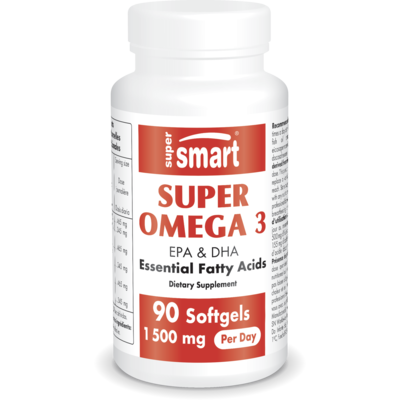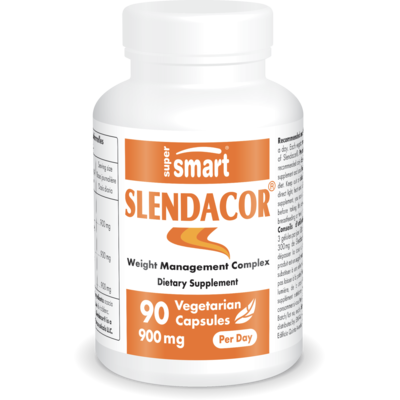Hypertriglyceridaemia: what can you do about it ?
Having high blood triglycerides can pose a risk to health. The good news is there are ways in which it can be dramatically lowered. Read on for all the details.

What exactly are triglycerides?
Like cholesterol, triglycerides are a type of lipid. They are produced when we consume fats, especially saturated fats, as well as when the liver converts them from sugars and alcohol.
These insoluble fatty acids are stored in adipose tissue for release as and when the body needs energy.
The problem is that an excessively high level of blood triglycerides is a risk factor for certain health conditions such as cardiovascular disease.
What constitutes a healthy blood triglyceride level?
The upper level recommended for blood triglycerides is 1.7 mmol/L of blood.
A level below that is considered normal and safe.
Elevated triglycerides: what are the symptoms?
Having a high level of blood triglycerides is generally asymptomatic. In other words, you probably won’t realise there’s a problem unless you have a blood test...
In more severe forms, however, a number of symptoms may develop:
- abdominal pain;
- a change in general condition;
- the appearance of yellowish skin lesions, called eruptive xanthomatosis.
What are the risks?
In the short term, a high blood triglyceride level known as hypertriglyceridaemia, will not cause pain, fatigue or loss of energy.
But in the medium and long term, it presents a real risk to health. It promotes the onset of atherosclerosis (the formation of fatty deposits in the arteries). The arteries may become clogged, potentially blocking blood flow, which can result in thrombosis, phlebitis, heart attack or stroke.
Causes of hypertriglyceridaemia
Elevated blood triglyceride levels are usually caused by poor dietary habits. The risk is particularly high in cases of excessive consumption of sugars, alcohol and unhealthy fats.
The problem may originate in metabolic disorders such as diabetes, excess weight and obesity.
Hypertriglyceridaemia can also be caused by genetic abnormalities.
There are also several drugs that can increase blood triglycerides such as corticosteroids, as well as some anti-psychotic and anti-viral medications, and certain contraceptives.
Finally, other factors likely to affect triglyceride levels include:
- advancing age;
- smoking;
- lack of exercise.
What can you do about elevated triglycerides?
As the problem is usually asymptomatic, the first step is to talk to your doctor and arrange to have a blood test if you suspect you have hypertriglyceridaemia.
If it turns out you do have elevated triglyceride levels, there are a number of ways you can address the problem.
Change your diet
The most urgent step is to modify your eating habits. First and foremost, you need to reduce your consumption of fast-release sugars including fructose. Eating more vegetables and wholegrains will always help and yield benefits.
You’ll also need to eat less saturated fat, reducing your consumption of butter, charcuterie, cheese, fatty meats, and above all, processed foods.
Instead, you should focus on fish including oily fish, and lean meats, as well as water, olive oil, avocados, dried fruit…
Drink less alcohol and coffee, and don’t smoke
If you’re a regular drinker, reducing your consumption of alcohol should be a high priority.
Stimulants are also aggravating factors. Coffee and triglycerides don’t mix... and the same goes for cigarettes.
Adopt new, healthier habits
Apart from poor dietary habits, certain lifestyle factors can also promote high blood triglycerides. These include stress, a sedentary lifestyle and excess weight.
Taking regular exercise, going out more often and adopting an altogether more positive lifestyle will definitely have a beneficial effect.
What if it’s caused by medication?
Keep in mind that certain drug treatments can increase blood triglycerides. If you’re at all worried, speak to your doctor.
How are elevated triglycerides treated?
Drugs
Your doctor may ultimately prescribe lipid-lowering drugs.
Of course, taking such medications is not without risk and may indeed cause side-effects. They should always be taken under regular medical supervision.
Natural substances that can help
There are several natural substances that can help in the case of elevated triglyceride levels:
- one such option is omega-3 essential fatty acids which help maintain normal triglyceride levels (1);
- pantethine, a derivative of vitamin B5, is being studied for its potential to lower excess triglycerides and ‘bad’ cholesterol (see Pantethine) (3);
- the composition of Slendacor (a blend of extracts of Curcuma longa root, Moringa oleifera leaf and Murraya koenigii leaf) may also have a positive effect on cholesterol and triglyceride levels (4-6);
- last but not least, there’s short-chain triglycerides (7), which are rapidly converted into ketones and not stored in adipose tissue (you’ll find them, for example, in Organic MCT Oil).
SuperSmart ADVICE
References
- Krupa K, Fritz K, Parmar M. Omega-3 Fatty Acids. [Updated 2023 Jan 17]. In: StatPearls [Internet]. Treasure Island (FL): StatPearls Publishing; 2023 Jan-. Available from: https://www.ncbi.nlm.nih.gov/books/NBK564314/
- Villano I, La Marra M, Allocca S, Ilardi CR, Polito R, Porro C, Chieffi S, Messina G, Monda V, Di Maio G, Messina A. The Role of Nutraceutical Supplements, Monacolin K and Astaxanthin, and Diet in Blood Cholesterol Homeostasis in Patients with Myopathy. Biomolecules. 2022 Aug 14;12(8):1118. doi: 10.3390/biom12081118. PMID: 36009012; PMCID: PMC9405860.
- Evans M, Rumberger JA, Azumano I, Napolitano JJ, Citrolo D, Kamiya T. Pantethine, a derivative of vitamin B5, favorably alters total, LDL and non-HDL cholesterol in low to moderate cardiovascular risk subjects eligible for statin therapy: a triple-blinded placebo and diet-controlled investigation. Vasc Health Risk Manag. 2014 Feb 27;10:89-100. doi: 10.2147/VHRM.S57116. PMID: 24600231; PMCID: PMC3942300.
- Vera-Ramirez L, Pérez-Lopez P, Varela-Lopez A, Ramirez-Tortosa M, Battino M, Quiles JL. Curcumin and liver disease. Biofactors. 2013 Jan-Feb;39(1):88-100. doi: 10.1002/biof.1057. Epub 2013 Jan 10. PMID: 23303639.
- Kashyap P, Kumar S, Riar CS, Jindal N, Baniwal P, Guiné RPF, Correia PMR, Mehra R, Kumar H. Recent Advances in Drumstick (Moringa oleifera) Leaves Bioactive Compounds: Composition, Health Benefits, Bioaccessibility, and Dietary Applications. Antioxidants (Basel). 2022 Feb 16;11(2):402. doi: 10.3390/antiox11020402. PMID: 35204283; PMCID: PMC8869219.
- Kundimi S, Kavungala KC, Sinha S, Tayi VNR, Kundurthi NR, Golakoti T, Davis B, Sengupta K. Combined extracts of Moringa oleifera, Murraya koeingii leaves, and Curcuma longa rhizome increases energy expenditure and controls obesity in high-fat diet-fed rats. Lipids Health Dis. 2020 Aug 28;19(1):198. doi: 10.1186/s12944-020-01376-7. PMID: 32859217; PMCID: PMC7455912.
- Schönfeld P, Wojtczak L. Short- and medium-chain fatty acids in energy metabolism: the cellular perspective. J Lipid Res. 2016 Jun;57(6):943-54. doi: 10.1194/jlr.R067629. Epub 2016 Apr 14. PMID: 27080715; PMCID: PMC4878196.
Keywords
3 Days
A Product worth waiting for when not…
A Product worth waiting for when not available and then arriving as a surprise!
DOMINIC
4 Days
On time shipping
On time shipping
GEORGE Verne
6 Days
Ordering was easy and the product was…
Ordering was easy and the product was delivered with no problems. Appreciated that I was notified when it would arrive. Thanks!
MascarC
12 Days
Great customer service - responsive …
I ordered from them and my item was unavailable for sometime. I was super happy when they reactivated my order and shipped my item which arrived very quickly. Great customer service.
Ruth Rueter
12 Days
Super fast shipping
Super fast shipping
Donald Borling
16 Days
Reputable companysearch and the number of…
The research and the number of selection of products.
NAKHJAVAN Shervin
29 Days
The Anti Aromatase is a great product
The Anti Aromatase is a great product. You just need to have constant inventory. Recently this product has been out of stock.
GEORGE Verne
30 Days
Great help on chat
Great help on chat. Knowledgeable and friendly.
Jason Argos
34 Days
Customer service was fast and friendly.
Customer service helped to stop the transaction process of the subscription. I appreciated that.
Greenie
34 Days
I order here due to the high quality of…
I order here due to the high quality of the products and the quick delivery of items - thank you
Barbara J
35 Days
SuperSmart's Eye Pressure supplements: highly recommended!
I purchase SuperSmart's Eye Pressure supplements regularly for over 5 years, and gotta say they are truly a wonderful product for my Glaucoma. Highly recommended if you have eye pain from your Glaucoma.
D. Martinez
40 Days
Quick service
Quick service
MONELL
41 Days
Speedy service.
Speedy service.
ROSENTHAL Marvin
44 Days
Clear website- Efficient
Clear website. Excellent search engine and fast delivery!
Mohamad Hussein
47 Days
They have great products.
They have great products.
Vickie








